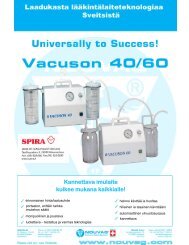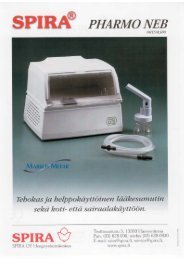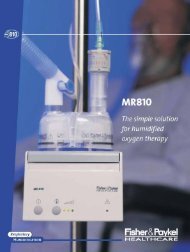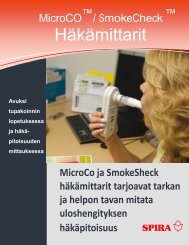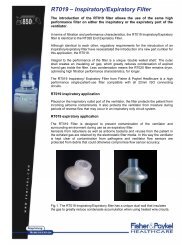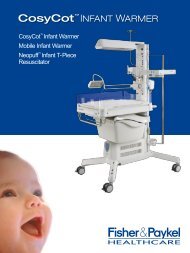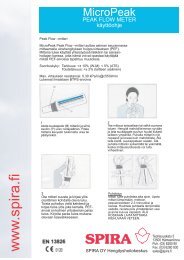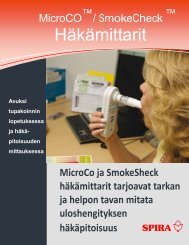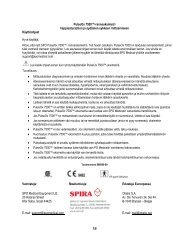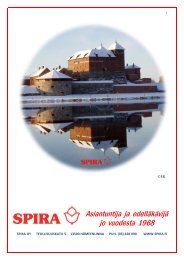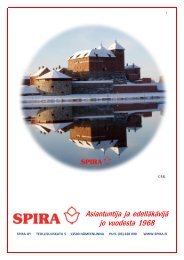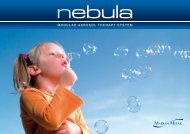Neopuff™ Infant T-Piece Resuscitator Clinical Paper ... - Spira
Neopuff™ Infant T-Piece Resuscitator Clinical Paper ... - Spira
Neopuff™ Infant T-Piece Resuscitator Clinical Paper ... - Spira
Create successful ePaper yourself
Turn your PDF publications into a flip-book with our unique Google optimized e-Paper software.
Neopuff <strong>Infant</strong> T-<strong>Piece</strong> <strong>Resuscitator</strong><br />
<strong>Clinical</strong> <strong>Paper</strong> Summaries
Ventilation of Very Preterm <strong>Infant</strong>s in the Delivery Room<br />
Arjan B. te Pas and Frans J. Walther<br />
Curr Pediatr Rev 2006; 2: 187-197<br />
AIM: To summarize current evidence on various elements of neonatal ventilation in the delivery room.<br />
DISCUSSION:<br />
Peak Inspiratory Pressure (PIP)<br />
Resuscitation guidelines recommend a PIP between 20-40 cmH 2<br />
O for term and preterm infants. However<br />
these pressures, if maintained for 1 second, cannot establish adequate inflation volumes in asphyxiated<br />
neonates or preterm infants. This means that higher pressures are necessary in the first manual breaths<br />
to open the lungs. To overcome the problems presented with using potentially dangerous high pressures,<br />
prolonged inflation times (15-20 seconds) at 20-25 cmH 2<br />
O may be used to overcome the long time constant<br />
of a fluid filled lung for preterm infants.<br />
Positive End Expiratory Pressure (PEEP)<br />
A 2001 survey showed that 59% of neonatologists in the USA use PEEP during resuscitation. The use of<br />
PEEP up to 12 cmH 2<br />
O in ventilation and resuscitation of infants and lambs increases compliance, oxygenation<br />
and functional residual capacity (FRC). More randomized controlled clinical trials are needed.<br />
Resuscitation Devices<br />
Self-inflating bags are adequate to deliver the required tidal volumes but cannot deliver a constant PIP and<br />
an adequate PEEP. Flow-inflating bags are technically challenging so inexperience and improper techniques<br />
can lead to dangerously high pressures, sometimes 15 cmH 2<br />
O above the target pressure. The Neopuff<br />
is a purpose-built mechanical device which is easy to use, even by inexperienced operators. Studies on<br />
an intubated mannequin revealed that whereas it is difficult to deliver sustained breaths with self and flow<br />
inflating bags, the Neopuff® delivers a more consistent and precise PIP and PEEP even during sustained<br />
inflation.<br />
Oxygen Concentration<br />
International guidelines recommend the use of 100% oxygen during resuscitation. There is mounting concern<br />
that high concentrations of oxygen may act as a lung irritant and trigger inflammatory responses and oxidative<br />
stress in the newborn. However, there is insufficient evidence from existing studies to recommend using<br />
room-air instead of 100% oxygen. Further trials are needed.<br />
Nasal Continuous Positive Airway Pressure (nCPAP)<br />
Using nCPAP directly after resuscitation is a gentle, non-invasive way to keep the lung open by maintaining<br />
lung volume, preventing atelectasis and stimulating respiration. NCPAP also reduces injury to the lung, the<br />
need for intubation in the delivery room, progression to mechanical ventilation and the amount of surfactant<br />
needed. Although the use of nCPAP is associated with a reduction in mortality of preterm infants there is still<br />
insufficient information to evaluate the effectiveness of prophylactic nCPAP in very preterm infants.<br />
TAKE HOME POINTS:<br />
• During resuscitation, it is possible to open the lung using sustained inflations of 5 – 20 seconds.<br />
• The best and easiest way to deliver a consistent and sustained PIP and adequate PEEP is a<br />
pressure-limited mechanical device with a T-piece i.e. the Neopuff® <strong>Infant</strong> <strong>Resuscitator</strong>.<br />
• Using PEEP during resuscitation helps maintain FRC, and reduces lung injury, the need for<br />
intubation, mechanical ventilation and surfactant.<br />
• 100% oxygen concentration is still recommended during resuscitation of preterm infants<br />
although there is increasing concern about oxygen toxicity. Further trials required.<br />
• nCPAP is an efficient and gentle way to keep the lung open in the delivery room and may reduce<br />
lung injury and avoid intubation and mechanical ventilation of preterm infants.
Comparison of three manual ventilation devices using an intubated<br />
mannequin<br />
Hussey SG, Ryan CA, Murphy BP.<br />
Arch Dis Child Fetal Neonatal Ed. 2004; 89; F490 – F493<br />
AIM: To compare three devices, the Fisher & Paykel Healthcare Neopuff <strong>Infant</strong> T-<strong>Piece</strong> <strong>Resuscitator</strong>,<br />
anesthesia bag with attached manometer (Intersurgical) and self inflating bag (Laerdal) for manual neonatal<br />
ventilation, using an intubated Fisher & Paykel Healthcare resuscitation doll.<br />
METHOD: The 35 participants were neonatal health workers that ranged from neonatal nurses, consultant<br />
pediatricians and anesthetists, to an emergency medical technician, and a midwife. Participants were<br />
recruited at in-service training days throughout Ireland. The self inflating bag had a pop off valve set to<br />
activate at PIPs (Peak Inspiratory Pressures) in excess of 40 cmH 2<br />
O, but no manometer to reflect current<br />
clinical use. The anesthetic bag did not incorporate a flow control valve, but the operator could control the<br />
volume and pressure of the bag by adjusting egress at the open end of the bag. The Neopuff PIP and<br />
PEEP (Positive End Expiratory Pressure) settings were preset by each participant before testing.<br />
Each participant was asked to provide positive pressure ventilation to an intubated Fisher & Paykel<br />
Healthcare resuscitation doll for two minutes using each device, aiming to achieve a PIP of 20 cmH 2<br />
0<br />
and a PEEP of 4 cmH 2<br />
0 and a breath rate of 40 breaths per minute. They were allowed to observe the<br />
manometer while using the anesthesia bag and Neopuff. They were not allowed to view a timer clock or<br />
their continuous recordings for any of the devices.<br />
RESULTS: Significant differences were found between devices.<br />
Response Self Inflating bag Anesthetic bag Neopuff p Value<br />
Max PIP 75.9 35.5 22.4 -<br />
Mean Max PIP 44.7 (2.3) 22.6 (0.7) 20.4 (0.5) < 0.001<br />
Mean PIP 30.7(1.9) 18.1 (0.4) 20.1 (0.1) < 0.001<br />
Mean PEEP 0.15 (0.03) 2.83 (0.23) 4.41 (0.08) < 0.001<br />
Mean Airway<br />
Pressure<br />
7.6 (0.8)* 8.5 (0.3)* 10.9 (0.3) < 0.001<br />
Mean rate 47.1 (3.0)* 47.3 (2.7)* 39.7 (1.8) < 0.05<br />
% total breaths ≤<br />
21 cm H20 PIP<br />
% total breaths ≥<br />
30 cm H20 PIP<br />
39 (0.07)# 92 (0.02)* # 98 (0.02)* # < 0.001<br />
45 (0.07) # 0*# 0*# < 0.001<br />
Values are mean cm of H20 (SEM – Standard Error of the Mean) except for # which are percentage (SEM)<br />
* Not significantly different within the same row (p > 0.05)
The performance of the Neopuff was more consistent and reliable when compared with the other two<br />
devices. There was a significant statistical difference between the Neopuff and both the anesthesia<br />
bag and self inflating bag with regard to PIP, PEEP, mean airway pressure and breath rate. The self<br />
inflating bag produced negligible PEEP, and greater mean and maximum PIP than the anesthetic bag and<br />
Neopuff.<br />
Using the Neopuff:<br />
• the mean and maximum PIP were more consistent and closer to the target value<br />
• the mean PEEP values were significantly higher and closer to the target value<br />
• the mean airway pressure was significantly greater<br />
• the applied breath rate was more consistent, reliable and closer to the target rate.<br />
There were no significant differences between the performance of the doctors and allied health<br />
professionals.<br />
DISCUSSION: The ability to provide consistent manual ventilation is dependent on the device. Self<br />
inflating devices without a manometer and a PEEP valve give excessively high PIP and minimal PEEP and<br />
should not be used with VLBW infants.<br />
Appropriate use of the anesthetic bag is dependent on adequate training and practice, otherwise the device<br />
is potentially dangerous.<br />
It is not mentioned that in order to provide a safe PIP and consistent PEEP when using the anesthesia bag,<br />
it is necessary to continuously watch the manometer, while when using the Neopuff one is free to watch<br />
the infant.<br />
The PIP and PEEP values provided by the Neopuff are independent of user stress, fatigue level and skill.<br />
TAKE HOME POINTS:<br />
• The Neopuff was the most consistent and reliable device, providing statistically more consistent<br />
and appropriate PIP and PEEP, significantly greater mean airway pressure and a breath rate that<br />
was most consistent and closest to target.<br />
• Self inflating devices without a manometer should not be used.<br />
• This study concludes that the Neopuff should be incorporated into Neonatal resuscitation training<br />
programs to provide PEEP and controlled PIP.
Neonatal resuscitation: raising the bar<br />
Finer N.N. and Rich W.D.<br />
Curr Opin Pediatr 2004; 16: 157-162<br />
AIM: To provide an overview of neonatal resuscitation practices with an emphasis on interventions that are<br />
not currently accepted or adapted into existing resuscitation guidelines.<br />
DISCUSSION:<br />
Resuscitation Environment<br />
In the NICU, an infant has: servo-controlled temperature, continuously monitored vital signs, heated,<br />
humidified and blended respiratory support, accurately controlled PIP and PEEP or CPAP. However, just 5<br />
minutes beforehand during resuscitation an infant has: heart rate determined by palpation or auscultation,<br />
oxygenation determined by color, ventilation using cold, dry, 100% O 2<br />
and poorly controlled PIP and PEEP.<br />
These differences appear paradoxical and irrational.<br />
Temperature Support<br />
The authors report that the percentage of infants in their resuscitation suite (weighing less than 1250g at<br />
birth) with admission temperatures less than 36°C decreased from 33% to 15% by<br />
(1) increasing environmental temperature from 18°C to 25°C,<br />
(2) providing functional radiant warmers, and<br />
(3) providing a polyethylene occlusive wrap as soon as possible after delivery.<br />
Few resuscitation teams offer the necessary servocontrolled temperature support by applying a temperature<br />
sensor to the infant’s skin at delivery.<br />
Oxygen Intervention<br />
Traditionally, 100% oxygen is used during resuscitation of extremely low birth weight (ELBW) infants. Mounting<br />
evidence suggests that decreasing oxygen requirements during the resuscitation of premature infants is<br />
beneficial. However, more randomized trials are required to establish specific outcomes. Even though the<br />
use of gas blenders are a standard practice in the neonatal intensive care unit (NICU) and both compressed<br />
air and oxygen are commonly available facilities, gas blenders are seldom incorporated into resuscitation<br />
beds.<br />
Positive Pressure Ventilation<br />
Continuous prolonged inflations are used in neonatal resuscitation to establish functional residual capacity<br />
(FRC) and larger tidal volumes. There is a need to determine the best methodology to provide adequate but<br />
not excessive ventilation to the premature lung in terms of positive pressure ventilation. T-piece resuscitators<br />
as opposed to self inflating and anesthesia bags have been shown to deliver ventilation more successfully<br />
in that they are easier to use, provide more consistent positive end expiratory pressure (PEEP) and peak<br />
inspiratory pressure (PIP) and are the only devices that can effectively deliver constant prolonged inflation.<br />
TAKE HOME POINTS:<br />
• The current difference in infant care between the delivery room (cold, dry gas, 100% O 2<br />
, and poorly<br />
controlled PIP and PEEP) and NICU (heated/humidified blended gas, accurately controlled PIP and<br />
PEEP or CPAP) appears paradoxical and irrational.<br />
• Using radiant warmers, increasing NICU environmental temperatures and using occlusive wraps are<br />
associated with a significant increase in mean admission temperature and survival of ELBW infants.<br />
• Few resuscitation teams offer the necessary temperature servocontrol at delivery to protect against<br />
hypothermia.<br />
• Most neonatologists attempt to use PEEP during resuscitation. T-piece resuscitation devices are<br />
the most successful at delivering PEEP, PIP and prolonged inflations.
Resuscitation of Premature <strong>Infant</strong>s: What Are We Doing Wrong and Can We Do<br />
Better?<br />
O’Donnell C.P.F., Davis P.G. and Morley C.J.<br />
Biology of the Neonate 2003; 84:76-82<br />
AIM: To outline the principles and efficacy of current neonatal resuscitation devices and techniques and<br />
identify areas of further research. This will lead to better guidelines and international consensus statements<br />
on the appropriate methods used for resuscitation of premature infants.<br />
DISCUSSION:<br />
Role of PEEP<br />
Lamb studies by the authors showed that the use of PEEP during resuscitation improves oxygenation,<br />
respiratory compliance (by 25%) and maintains functional residual capacity (FRC), thereby reducing the<br />
progression to respiratory distress syndrome (RDS).<br />
Resuscitation Devices<br />
The greatest assets of the self-inflating bag are perceived to be the automatic re-expansion and ease of use.<br />
However, these may be falsely reassuring as a large proportion of the delivered breath may be unknowingly<br />
lost through leak around the mask. The self-inflating bag is unable to deliver a consistent PIP - which depends<br />
on the strength and speed of bag compression, the seal of the facemask and the respiratory compliance - or<br />
normally provide PEEP, or deliver prolonged inflations. Pressures produced by Flow-inflating bags can vary<br />
considerably because of difficulties with operator skill in controlling outlet gas flow and bag squeeze. Poor<br />
technique can produce inconsistent PIP and PEEP, and pressures may reach dangerously high levels. The<br />
Neopuff® is a T-piece resuscitation device with a variable PEEP valve, PIP control, and has a manometer<br />
to show delivered pressure. It can produce a constant PEEP for a given flow, PIP for every breath and can<br />
be adjusted according to clinical response. The Neopuff® is easy to use even by relatively inexperienced<br />
operators.<br />
Heat and Humidification during Neonatal Resuscitation<br />
In the NICU, care and attention are given to heat and humidify respiratory gas. It is therefore surprising that<br />
dry, cold gas is used for resuscitation in the delivery room<br />
TAKE HOME POINTS:<br />
• Lamb studies show that PEEP during resuscitation improves respiratory outcomes.<br />
• Re-expansion and ease of use are perceived assets of the self-inflating bag. These may be falsely<br />
reassuring as a large portion of the breath may be unknowingly lost through leak around the mask.<br />
• Flow-inflating bags are difficult to use and therefore produce inconsistent PEEP and sometimes<br />
dangerous pressures.<br />
• The Neopuff® is a T-piece resuscitation device with a variable PEEP valve, PIP control and a<br />
manometer. The Neopuff® is better than self and flow-inflating bags at providing safe consistent<br />
PIP, constant PEEP and delivering prolonged inflations.<br />
• Heated and humidified gas - as opposed to cold and dry - should be considered for resuscitation of<br />
infants, following the preparation of respiratory gases used in the NICU.
Comparison of methods of bag and mask ventilation for neonatal<br />
resuscitation<br />
Finer NN, Rich W, Craft A, Henderson C<br />
Resuscitation 2001, 49: 299-305<br />
AIM: To determine the ability of different operators to reliably deliver pre-determined inspiratory and endexpiratory<br />
pressures for neonatal resuscitation using currently available devices.<br />
METHOD: Five nurses, two neonatal nurse practitioners, four neonatologists, six neonatal fellows, five<br />
pediatric residents and five neonatal respiratory therapists were evaluated over two days. A neonatal<br />
manikin (Laerdal Armonk, NY) with a functional larynx and lungs was utilized for resuscitation. The following<br />
devices were used: a 500 mL latex-free disposable anesthesia type bag (Model 5126 Vital Signs), a<br />
500 mL Jackson-Rees type anesthesia bag (Model E191 Anesthesia Associates) fitted with a Norman<br />
elbow and a flow-control tail-piece and the Neopuff (Fisher & Paykel, Auckland NZ). The participants were<br />
asked to ventilate the manikin with a bag and mask using all three devices for 30 s at a rate of 30 breaths/<br />
min., a peak inspiratory pressure (PIP) and positive end-expiratory pressure (PEEP) of 25 and 5 cmH 2<br />
O,<br />
respectively. Then they were to deliver a breath of 5 s duration, followed by a further 30 s of bag and mask<br />
ventilation, and a second 5 s inflation. The results were analyzed using SigmaStat software.<br />
RESULTS: There were significant differences in PIP and PEEP between operators using either anesthesia<br />
bag (P
The importance of ventilation to effective resuscitation in the term and preterm<br />
infant<br />
Milner A.<br />
Semin Neonatol 2001; 6: 219-224<br />
AIM: To review available guidance data on how ventilatory support should be provided to infants who are slow<br />
to take the first steps in cardiorespiratory adaptation after delivery.<br />
DISCUSSION:<br />
Self-inflating vs. T-piece Technique<br />
Bag and mask resuscitation is relatively ineffective and probably relies on Head’s Paradoxical Reflex to<br />
stimulate inspiratory efforts. Although self-inflating resuscitation devices are most frequently used, the main<br />
factor limiting their performance is the pressure-limiting leaks that prevent the inflation pressure from being<br />
maintained for more than 0.5 seconds. This is insufficient time to deliver adequate ventilation. When using<br />
the T-piece technique, inflation pressures can be maintained for longer periods to overcome the long time<br />
constant of the fluid-filled lung. Studies show that the T-piece device is easier to use, requires only one hand<br />
and produces more effective tidal exchange than self-inflating devices.<br />
Pressures<br />
The intention is that sufficient pressure should be given to produce adequate but not excessive lung expansion<br />
at birth. Current practice is to use inflation pressures of between 20 – 30 cmH 2<br />
O. A self-inflating reservoir<br />
with a pressure limiting valve is commonly used for lung expansion. Very rapid manual compression can<br />
lead to high pressures and most have the provision to override the pressure relief valve leading to pressures<br />
greater than 60 cmH 2<br />
O.<br />
PEEP/CPAP<br />
There is increasing interest in the use of positive end expiratory pressure (PEEP) with resuscitation to help<br />
establish FRC, conserve surfactant and thus reduce the frequency and severity of RDS.<br />
TAKE HOME POINTS:<br />
• Bag and mask resuscitation is relatively ineffective and probably relies on Head’s Paradoxical<br />
Reflex to stimulate inspiratory efforts.<br />
• The performance of self-inflating devices is limited by the pressure-limiting leaks that prevent<br />
inflation times of more than 0.5 seconds.<br />
• A T-piece device can maintain pressure for longer periods, is easier to use, requires only one hand,<br />
and produces more effective tidal exchange.<br />
• There is increasing interest in the role of PEEP to establish FRC and conserve surfactant.
The “Educated Hand”. Can anesthesiologists assess changes in neonatal<br />
pulmonary compliance manually?<br />
Spears RS, Yeh A, Fisher DM, Zwass MS.<br />
Anesthesiology 1991, 75(4): 693-696.<br />
AIM: To evaluate the ability of anesthetic clinicians to detect changes in “pulmonary” compliance during hand<br />
ventilation of an in vitro model.<br />
METHOD: 24 clinicians were divided into 4 experience levels ranging from inexperienced residents to fully<br />
trained pediatric anesthetists. They were tested using 3 different anesthesia circuits i) Mapleson D (Anesthesia<br />
Medical Specialties) ii) pediatric circle system without humidifier and iii) pediatric circle system humidifier with<br />
either a 1L (small) or 2L (large) lung model. These models were intended to correspond to preterm and fullterm<br />
neonatal lungs, respectively. Clinicians were asked to provide 15 cmH 2<br />
O PIP for the small lung and<br />
20 cmH 2<br />
O PIP for the large lung, and airway pressures were detected with a conventional manometer within<br />
the circuit. Measurements were made over a 5 min period. Clinicians were informed that the endotracheal<br />
tube (ETT) on the model could be clamped at any time, and they were instructed to indicate when they<br />
detected this change. They were required to simultaneously record a number of physiological parameters in<br />
an attempt to simulate conditions within an operating room.<br />
RESULTS: In each of the three circuit types, only 4 of the 24 clinicians were able to detect changes in<br />
compliance of the large lung and only 1 of the clinicians detected it in the small lung. The level of experience<br />
of the clinicians did not predict their ability to detect occlusion of the circuit.<br />
DISCUSSION: Hand ventilation of infants during anesthesia is frequently recommended over mechanical<br />
ventilation since it is contended that this allows more rapid detection and compensation for changes in<br />
pulmonary compliance. The changes produced in the study by complete occlusion of the ETT were more<br />
marked than those that might normally occur in the clinical setting. This suggests that these smaller changes<br />
in compliance in-vivo may not be detected when hand ventilating an infant.<br />
TAKE HOME POINTS:<br />
• Anesthetists are not able to consistently detect changes of lung compliance during manual<br />
ventilation of a lung model. Since the level of change in compliance of the model was large,<br />
this suggests that in a real clinical situation they would be unable to detect small changes and<br />
respond appropriately.<br />
• The ability to detect compliance is not related to the clinician’s level of experience.<br />
• If clinicians are unable to detect changes in compliance manually, then the benefits of mechanical<br />
ventilation must be considered.
Evaluation of manometer use in manual ventilation of infants in neonatal<br />
intensive care units.<br />
Howard-Glenn L, Koniak-Griffin D.<br />
Heart & Lung 1990, 19(6): 620-7.<br />
AIM: To investigate the variation in peak inspiratory pressure (PIP) produced by neonatal nurses when<br />
manually ventilating infants, with and without the use of a manometer. Specifically:<br />
• Are nurses with more years of experience better able to control the PIP delivered than less<br />
experienced nurses?<br />
• Are nurses with more years of experience less likely to use manometers than less experienced<br />
nurses?<br />
• Do nurses using manometers have greater success in controlling prescribed PIP than those who<br />
do not use them?<br />
METHOD: Sixty NICU nurses (with experience ranging from 1–26 years) were observed while manually<br />
ventilating 22 intubated infants. This manual ventilation was performed with a 500 mL inflating resuscitation<br />
bag (Rusch Inc.) in the course of regular suctioning. A Pneumogard 1230A device was used to measure<br />
peak airway pressures and an observer recorded whether the nurses looked at the manometer during<br />
each individual breath.<br />
RESULTS: When a manometer was used, the nurses’ mean percentage of success in controlling PIP to<br />
within +/- 2 cmH 2<br />
O of the prescribed value was 78.01%. This value was 41.40% when the manometer was<br />
not used. A significant negative correlation was found between the number of years of NICU experience<br />
that each nurse had and their use of a manometer. There was no significant correlation between the<br />
number of years of NICU experience and the nurses’ ability to control prescribed PIP.<br />
DISCUSSION: While experienced nurses were found to be less likely to make use of a manometer than<br />
less experienced nurses, they were no more likely to deliver the right level of PIP. When nurses ventilated<br />
infants without looking at a manometer the PIP levels often exceeded the prescribed value, sometimes by<br />
two or three times the value. This has clinical implications in terms of an increased risk of lung injury.<br />
TAKE HOME POINTS:<br />
• When manual ventilation was performed with manometers, nurses in this study demonstrated<br />
greater success in controlling PIP.<br />
• Nurses with more experience tended to rely less on manometers and they often exceeded the<br />
prescribed PIP, frequently doubling or tripling the value.<br />
• Nurses overestimated how often they were looking at the manometer. During the middle of the<br />
resuscitation procedure observation number decreased with a decrease in successfully<br />
controlling PIP over that time.<br />
• The development of new equipment specifically designed to facilitate accurate delivery of<br />
prescribed inspiratory pressures during manual ventilation is also recommended. Additionally,<br />
resuscitator equipment with attached safety pressure-relief devices that can be set for a specific<br />
level appropriate to the size of the infant is needed.
Limitations of self-inflating resuscitators.<br />
Finer NN, Barrington KJ, Al-Fadley F, Peters KL.<br />
Pediatrics 1986, 77 (3): 417-420.<br />
AIM: To evaluate the performance of three self-inflating neonatal resuscitation bags.<br />
METHOD: Three examples of three pediatric self-inflating resuscitation bags were tested: Ohio Hope II<br />
<strong>Resuscitator</strong> (Ohio Medical Products), the PMR-2 <strong>Resuscitator</strong> (Puritan Medical Products) and the Laerdal<br />
Neonatal <strong>Resuscitator</strong> (AS Laerdal). The devices were connected to a test lung via an endotracheal tube<br />
and compressed at frequencies from 10 to greater than 60 breaths per minute. Oxygen flows of 5, 10<br />
and 15 L/min were used, with and without a reservoir. Target pressures were 20-25 cmH 2<br />
O, as well as<br />
pressures greater than the pop-off valve (POV) relief pressure. Measurements of airway pressure and<br />
oxygen concentration were continuously recorded. Tidal volume was also intermittently measured using<br />
a pneumotachograph.<br />
RESULTS: All devices, when equipped with reservoirs, delivered a significantly higher oxygen<br />
concentration than when equipped without reservoirs (p
Manual ventilation with a few large breaths at birth compromises the<br />
therapeutic effect of subsequent surfactant replacement in immature lambs<br />
Bjorklund LJ, Ingimarsson J, Curstedt T, John J, Robertson B, Werner O, Vilstrup CT.<br />
Pediatric Research. 1997, 42(3): 348-355.<br />
AIM: To determine whether as few as 6 large breaths, given shortly after birth, would blunt the therapeutic effect of<br />
subsequent surfactant replacement in immature lambs.<br />
METHOD: Five pairs of trachestomised preterm lamb siblings were randomized into 2 groups; one of each pair received<br />
6 large breaths at birth, and the other sibling acted as a control and received normal ventilation. The large breaths<br />
were administered using a Laerdal neonatal resuscitation bag. Breaths were 120-130 mL in size and held at maximal<br />
inspiration for 5s. All lambs were mechanically ventilated with an initial inspiratory pressure of 29 cmH 2<br />
O, but this<br />
was then increased until PaCO 2<br />
was ~6 kPa, up to a maximum of 40 cmH 2<br />
O. PEEP was initially 4 cmH 2<br />
O, but was<br />
increased to 6 cmH 2<br />
O in 2 animals to counteract hypoxia. Surfactant was given at 30 minutes after delivery. Chest<br />
radiographs were taken periodically throughout the study and examined for the presence of pneumothorax. Pressure<br />
Volume (PV) curves were produced by inflating the lungs to an airway pressure of 35 cmH 2<br />
O, maintaining the pressure<br />
for 15 s and then allowing the lungs to passively deflate through a flowmeter. These curves were taken, in addition to<br />
arterial blood gas samples, at multiple intervals through the 4 h study period. Another 3 lambs were given surfactant at<br />
birth, before ventilation was commenced. They were managed and monitored as above.<br />
After death the lungs were sectioned and examined microscopically. The effect of surfactant treatment was classified<br />
as satisfactory if ≥75% of the alveoli were estimated to be air-expanded, and evidence of lung injury was limited. It was<br />
rated as sub-optimal if the estimated proportion of aerated alveoli was between 50 and 75% and unsatisfactory if ≤50%<br />
of alveoli were air-expanded.<br />
RESULTS: Lung fluid taken at birth was found to be severely surfactant deficient in all 8 lambs tested. The PV curve<br />
became steeper with time following surfactant treatment in all lambs that were not exposed to large breaths. This effect<br />
was not seen in the bagged group. There were no significant differences between groups in arterial blood gas values<br />
before surfactant treatment. However, after surfactant treatment PaCO 2<br />
was greater in the bagged lambs despite<br />
attempts to reduce it by increasing inspiratory pressure. PaO 2<br />
was also transiently increased in the control group. Two<br />
of the bagged lambs had pneumothoraces at autopsy.<br />
Each of the 3 lambs given surfactant before the first breath had a higher PaO 2<br />
and inspiratory capacity (IC)/weight, and<br />
a lower PaCO 2<br />
than any of the 10 lambs that were given surfactant at 30min of age. At 4 hours IC/weight and deflation<br />
compliance/weight were greater, and inspiratory pressure less in each of these lambs than in any of those bagged at<br />
birth. The values in the group of sibling controls tended to be intermediate, with some overlap.<br />
DISCUSSION: While 2 of the control lambs were histologically defined as having optimal response to treatment, none of<br />
the bagged lambs were in this category. Two lambs from each group had a sub-optimal response and 3 bagged lambs<br />
and 1 control lamb had an unsatisfactory response to surfactant. In the group who received surfactant at birth, 2 had an<br />
optimal response, and one had a sub-optimal response. At 4 hours, the IC was significantly lower in those animals with<br />
an unsatisfactory response to surfactant than those with an optimal response.<br />
TAKE HOME POINTS:<br />
• “The main result of this study was that a few large breaths (35-40 mL/kg), given at birth to immature<br />
lambs, inhibited the effect on lung mechanics of subsequently instilled natural surfactant.”<br />
• Even when surfactant is administered before the first breath, a maximal inspiratory capacity is<br />
not established until around 1 hour, and there may still be an early period when the lung is sensitive to<br />
overdistension.”<br />
• “A few inflations with volumes that are probably harmless in other circumstances might, when forced<br />
into the surfactant-deficient lung immediately at birth, compromise the effect of subsequent surfactant<br />
rescue treatment. Our findings challenge current neonatal resuscitation practice of rapidly<br />
establishing a normal lung volume by vigorous ventilation.”
NOTE:These clinical paper summaries were written by the Neonatal Group of Fisher & Paykel Healthcare.<br />
Reviews such as this are provided free of charge to assist clinicians in caring for their patients. It is<br />
recommended that the time be taken to review the paper in full.<br />
REF: 185044888 Rev D 2008-11



